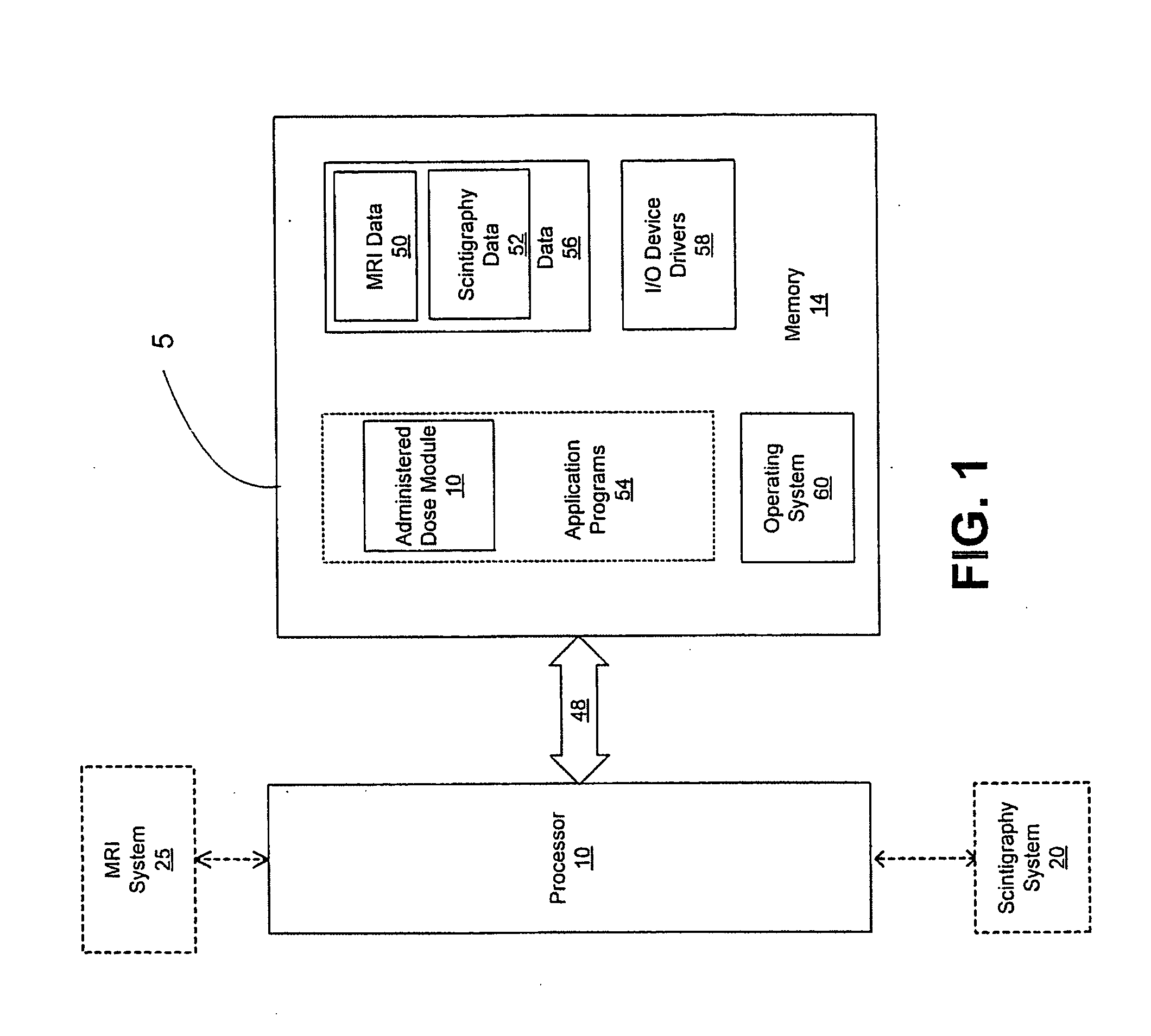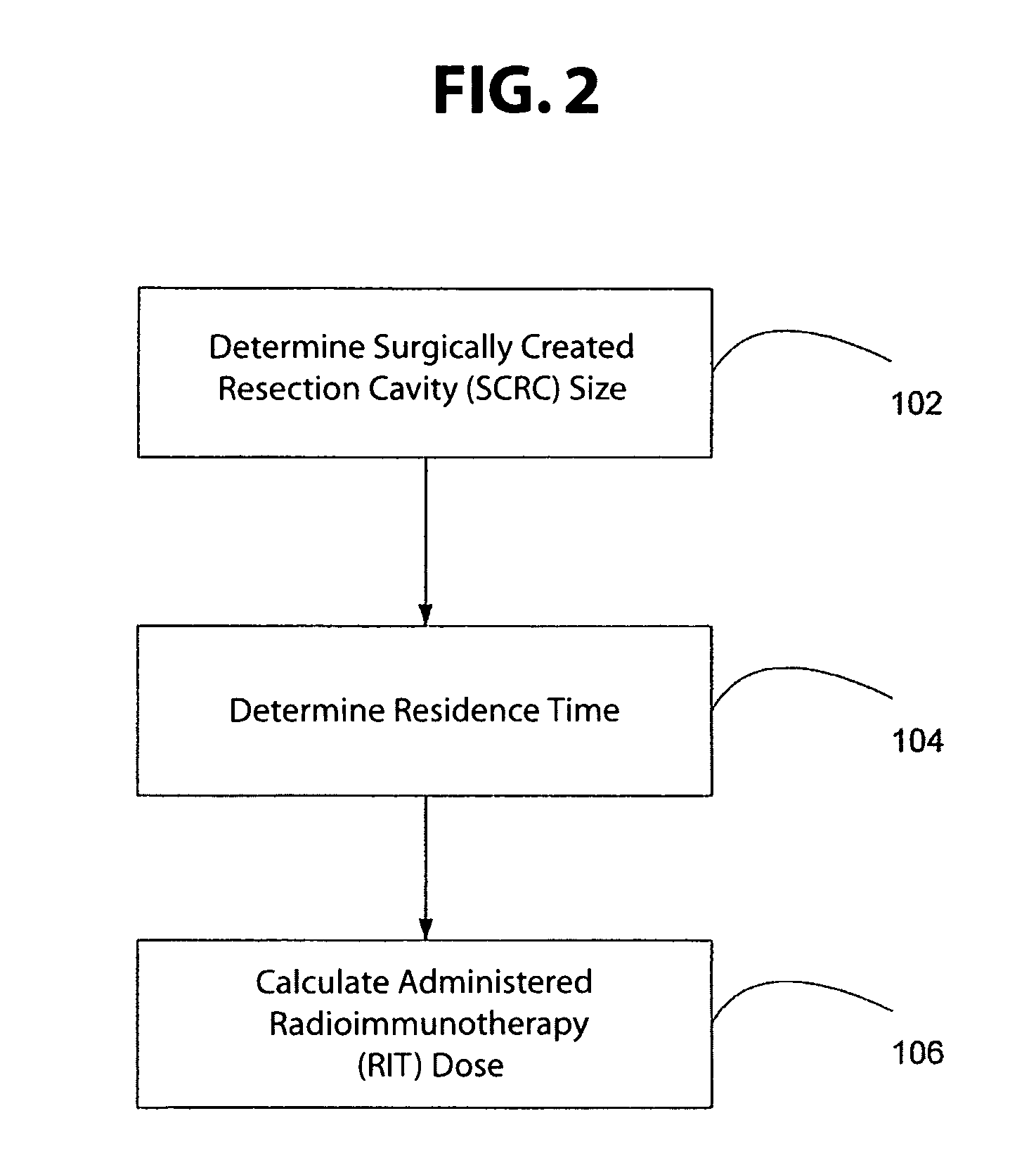Radiation dosimetry and blocking antibodies and methods and uses therefor in the treatment of cancer
a technology of radiation dosimetry and antibodies, which is applied in the field of radiation dosimetry and blocking antibodies and methods and uses therefor in the treatment of cancer, can solve the problems of not teaching the medical practitioner how, the radiation energy from the administered rit dose is actually deposited into healthy tissue, and the art is known to be extremely toxi
- Summary
- Abstract
- Description
- Claims
- Application Information
AI Technical Summary
Benefits of technology
Problems solved by technology
Method used
Image
Examples
example 1
Dosimetry of 131I-Labeled Murine 81C6 Monoclonal Antibody for an Absorbed Targeted Dose of 44 Gv
Basic Formulation
[0120] According to embodiments of the present invention, dosimetry estimates may be carried out in order to estimate the necessary administered activity A0 to achieve a targeted dose D of 44 Gy to the 2-cm cavity margins. The basic equation is given by
DSCRC=A0S(B2-cm←SCRC)τSCRC
where DSCRC is the targeted dose of 44 Gy, A0 is the administered activity expressed in mCi, S(B2-cm←SCRC) is the corresponding S-value in Gy hr mCi−1, and τSCRC the residence time in hr.
Scintigraphy Studies
[0121] 1. Whole-Body Scintigraphy.
[0122] Three or more sessions are used. Each session consists of 1) a whole-body image of the subject, 2) whole-body imaging of the background, and 3) whole-body imaging of a source vial containing initially approximately 200 μCi of 131I. The first session is acquired immediately after the administration of a dosimetric dose of 131I-labeled murine 81C6...
example 2
Phase II Study of 131-Iodine-Labeled Anti-Tenascin Murine Monoclonal Antibody 81C6 (m81C6) Administered to Deliver a Targeted Radiation Boost Dose of 44 Gy to the Surgically Created Cystic Resection Cavity Perimeter in the Treatment of Subiects with Newly Diagnosed Primary and Metastatic Brain Tumors.
[0133] The administration of 131I-labeled anti-tenascin monoclonal antibody 81C6 (131I-81C6) into a surgically created resection cavity (SCRC) improves survival for subjects with newly diagnosed and recurrent malignant glioma. Dosimetry analyses from previously-performed studies suggest that the delivery of 44 Gy to the SCRC by 131I-81C6 is associated with a low rate of toxicity and significant local tumor control. The primary objective of this Example is to evaluate the efficacy and toxicity of administering a dose of 131I-81C6 to achieve a 44 Gy boost to the SCRC perimeter. Eligibility criteria include: adults with newly diagnosed and previously untreated malignant glioma; gross tota...
example 3
Dosimetry and Radiographic Analysis of 131I-Labeled Anti-Tenascin 81C6 Murine Monoclonal Antibody in Newly Diagnosed Subiects with Malignant Gliomas: A Phase II Study
[0135] Dosimetry methods according to this invention may be used to estimate the necessary administered activity “AO” as follows: For the purpose of this example, it is assumed that the desired target dose “D” and the size of the cavity margin are known. In the Example, the target RAD (target dose “D”) is 44 Gy and the size of the cavity margin for which the administered radioimmunotherapy dose is being calculated is 2 cm. The S-value can be calculated using Monte Carlo simulations or by alternative means as known in the art. First, the following equation for “Dscrc” is used to determine the value for the administered activity “A0”:
DSCRC=A0S(B2-cm←SCRC)τSCRC
where DSCRC is the targeted dose of 44 Gy, A0 is the administered activity expressed in mCi, S(B2-cm←SCRC) is the corresponding S-value in Gy hr mCi−1, and τSCRC...
PUM
 Login to View More
Login to View More Abstract
Description
Claims
Application Information
 Login to View More
Login to View More - R&D
- Intellectual Property
- Life Sciences
- Materials
- Tech Scout
- Unparalleled Data Quality
- Higher Quality Content
- 60% Fewer Hallucinations
Browse by: Latest US Patents, China's latest patents, Technical Efficacy Thesaurus, Application Domain, Technology Topic, Popular Technical Reports.
© 2025 PatSnap. All rights reserved.Legal|Privacy policy|Modern Slavery Act Transparency Statement|Sitemap|About US| Contact US: help@patsnap.com



